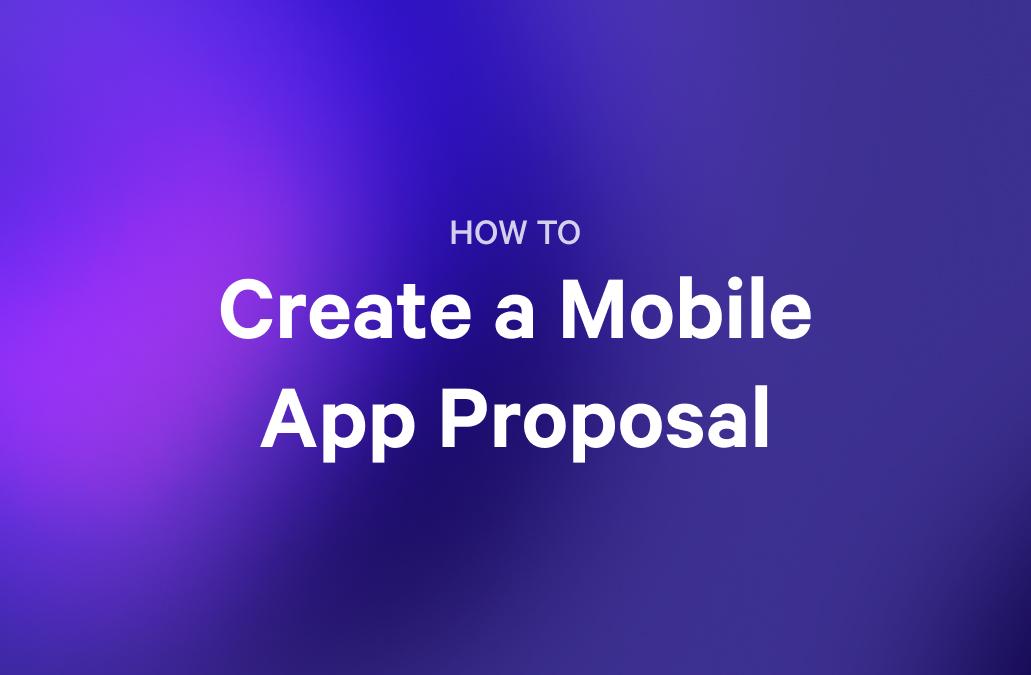An audit proposal can be years in the making. Depending on the industry of the client and the type of audit requested, the client’s invitation to tender can be issued more than 18 months in advance. Requests for proposal (RFP) for audit are usually sent only to a small handful of audit service providers.
This longer sales cycle means a tailored approach is essential to ensure that your proposal meets the tender requirements and demonstrates your suitability for the project. When creating a proposal that meets this high standard, it’s useful to work with proposal creation tools and templates that allow you to produce sleek, flexible, and responsive designs.
In this article, we will review some of the most important aspects of audit proposal creation and take you through the integral elements of a meticulously planned technical proposal.
Key takeaways
- Audit proposals require a tailored approach and can benefit from proposal creation tools for sleek, responsive designs.
- Different types of audits require different information in the proposal, highlighting the need for separate templates for each audit type.
- Building relationships with the Audit Committee at the target account can increase chances of receiving an audit RFP.
- A well-structured audit proposal includes sections like executive summary, scope of services, compliance requirements, project timeline, qualifications, costs, and specific RFP requirements.
- Qwilr’s audit proposal template provides a professional, customizable format for creating audit proposals.
What is an audit proposal?
An audit proposal is a business document, sent from an auditor to a potential client, that presents a formal offer of auditing services.
The two main types of audit are internal and external. An external audit helps businesses meet their obligations to external parties, such as the government, regulatory bodies, and shareholders.
Internal audits are at the discretion of the company. They’re subject to less stringent regulation and can be conducted if necessary by company employees (though many companies prefer to outsource the process to external auditors).
Different types of external audit include:
- Tax audit
- Global audit
- Employee benefit plan audit
- Compliance audit
- Payroll audit
- Information systems audit
- Operational audit (assessing core business operations)
The specific audit services required will dictate which information you choose to highlight in your proposal.
For example, the client may ask you to deliver a global audit, where a multinational company provides an account of its finances and operations across multiple countries or regions. This will require greater insight into the regulations and contexts across different countries and borders. Consequently, the client will be looking for a great deal of experience in international professional practices in your team.
As an auditor, if you provide several different kinds of audit, it makes sense to increase sales productivity with a separate audit agreement template for each kind of audit you provide.
Increasing your chances of receiving an audit RFP
Audit tenders (particularly tenders from larger companies with more complex requirements) are usually public knowledge well in advance of the audit period.
This early disclosure allows publicly traded companies to manage any ‘blowback’ or negative connotations associated with the audit process over a longer period. This can help reduce any ‘spooking' of the market and possible impact on share price.
From a sales perspective, this clear buying signal affords the auditor a hefty advantage - forewarned is forearmed. There’s no guarantee that you’ll make the shortlist of companies invited to provide audit services. You can improve your chances by implementing sales strategies (or methodologies such as target account selling) to develop relationships with the various individuals who comprise the Audit Committee at the target account.
These relationships will be vitally important should you win the contract - the client’s executive management team will seek auditors they can respect and trust to provide excellent service. Opening up the accounts for audit is the business equivalent of going to the dentist - a clear, professional ‘bedside manner’ is an essential tool for any auditor.
The key decision-maker to focus on is the CFO or finance director. While the Audit Committee may be comprised of a range of different individuals and opinions, the CFO will often be the auditor’s primary point of contact - their opinion will carry a lot of weight.
Steps to write an audit proposal: key elements to include
By the time you design and create your audit proposal, you’ll already have spent considerable time researching the account and gathering the information you need.
If you’ve been invited to submit a proposal, it’s likely that you’ve already established a relationship with the client’s management team, and possibly even spent time on-site at one or more of the client’s locations, assessing their audit needs.
You’ll have amassed a great deal of information by making research your priority. You'll now need to distill this into a persuasive and compelling argument for your services that clearly demonstrates your understanding of the client’s business, their needs, and their key personnel.
Creating your template around the following headings will help you formulate your argument and guide your client effectively through the sales process.
Executive summary
This introductory section needs to provide a high-level overview of how your proposal will meet the client's needs as outlined in their RFP.
Including every feature and benefit in this summary is unnecessary - it’s a broad-strokes argument that sets out why your audit service will provide the most effective solution to the client’s need. You can include any aspects of your approach that are unique to your company (particularly if your competitors are unable or unlikely to replicate your approach).
You can also provide any compelling evidence that your company is particularly well-suited to the project (i.e., awards or industry-relevant experience).
Any influential stakeholders outside the Audit Committee will be more likely to read this section than any other, so make sure you’ve presented your most compelling argument here.
Scope of services
This section can become very complicated, as you set out responsibilities for deliverables, as well as specific financial statements, tax filings and related items that pertain to each aspect of the services provided.
Give careful consideration to your presentation here - dropdown menus and accordions can be deployed here to maintain readability and avoid overwhelming the reader with technicalities.
Include plenty of detail, and look for ways to demonstrate your solid commercial understanding of the client’s needs, business, and industry.
Compliance and regulatory requirements
In this section, outline how your audit will ensure your client complies with any and all regulatory requirements at the local, state, and federal levels.
Make sure you include industry and business-specific compliance requirements too - for example, non-profits may be recipients of grants or contracts which contain their own stipulations.
Ideally, the client’s RFP will have outlined all necessary compliance requirements to support this section.
Project timeline
Your project timeline should clearly define all the activities and deliverables necessary for project completion within the audit period.
The audit completion date often hinges on the date of the board meeting, where the audit firm is expected to formally present the audit results to the board.
Using this date, you can work backwards to set provisional deadlines for draft financial statements, field work and other deliverables.
Your timeline depends on the timely delivery of information from the client - this can be reflected in your costs and fees, as we’ll explain below.
Qualifications and experience
The section outlining your team’s expertise and work experience is an essential component of your audit proposal.
Most clients prefer to work with auditors who are subject matter experts. You should have a proven track record in the client’s industry and a record of successful delivery of similar audits. Assuming that you can demonstrate this level of expertise, your focus in this section should be on providing a positive customer experience.
The finance team must be convinced that this working relationship will provide them with a flexible, stress-free solution to their auditing needs. Reducing friction at these early stages with a streamlined and clearly defined proposal will help to prove how easy you are to work with. Keep this in mind throughout the proposal creation process.
Costs and fees
The overall audit cost will be mostly dictated by the requirements the client has already outlined in the RFP. However, it’s possible to include some mechanisms for price flexibility. Structure your fees around the efficiencies that can be achieved if the client responds promptly to your document request processes. By delivering the correct information in an appropriate format at the right times, they can avoid paying a late fee. In this way, clients can be financially motivated to work more effectively with the audit process.
The pricing section of a sales proposal is usually a good place to explore upselling and cross-selling opportunities. However, for audit proposals, this opportunity is often constrained by strict legislation around auditor independence. Given the need for external audits to be conducted by independent auditors with no conflict of interest, any additional services should be offered in strict compliance with audit regulations.
If you aim to provide non-audit services for the client, then provide the client with clear guidance about how the audit services may affect other contracts in play.
Specific requirements from the RFP (optional)
This need for this section very much depends on what’s been specified by the client’s RFP. These conditions can vary greatly, depending on the industry, the client, and the type of audit required.
Ideally, you’ll have met any specific requirements elsewhere in the proposal - however, you may wish to be more explicit. For example, your client may have asked you to define specific areas of risk that your audit would focus on - in which case, a separate section such as this would be warranted.
Conclusion
Your conclusion section shouldn’t need to persuade further or add more information if the previous sections have been effectively designed.
Instead, use your conclusion to provide everything your client needs to close the deal. Links to T&Cs are useful here, along with e-signature functionality that allows your client to sign the contract without the need to click away or access any additional paperwork or documents.
Example of an audit proposal template
Qwilr’s audit proposal template provides everything you need to easily deliver a baseline proposal you can differentiate for different clients or types of audit.
You can immediately create your proposal following the professional format outlined here.
- Executive summary
- Scope of services
- Compliance and regulatory requirements
- Project timeline
- Qualifications and experience
- Costs and fees
- Specific requirements from the RFP (optional)
- Conclusion
Qwilr proposals are professionally designed and mobile-friendly. They’re instantly adaptable and customizable with any content you want to introduce. You can import your branding elements and seamlessly incorporate interactive elements such as embedded videos, image galleries, and interactive pricing tables for added impact.
Customize proposals to match the changing needs of the audit
Creating an audit proposal is often a long and complicated process. Your first draft often bears little resemblance to the finished proposal, so it’s essential to streamline your creation process using tools that allow you to customize your proposal instantly.
Creating a series of flexible, sleek, and professional templates to cover all audit eventualities will allow your team to ensure their proposals are firmly focused on the needs and details of the client. Qwilr’s 14-day free trial lets you see for yourself how much time you can save by using a professional sales proposal creation tool.
About the author

Dan Lever|Brand Consultant and Copywriter
Dan Lever is an experienced brand consultant and copywriter. He brings over 7 years experience in marketing and sales development, across a range of industries including B2B SaaS, third sector and higher education.
Frequently asked questions
An effective audit proposal should open with a stand-alone executive summary. The document created should also outline the following:
the scope of the audit program
the auditor’s qualifications and experience
compliance and regulatory requirements
the project timeline, costs, and fees
A comprehensive internal audit should look to establish a baseline for each of the four C’s - culture, competitiveness, compliance, and cybersecurity.
A request for proposal (RFP) is a document sent by a company to prospective auditors to help them create a sales proposal that reflects the company’s needs. It contains details about the type of audit required, the organizational structure, and the current operational and financial status of the company.


